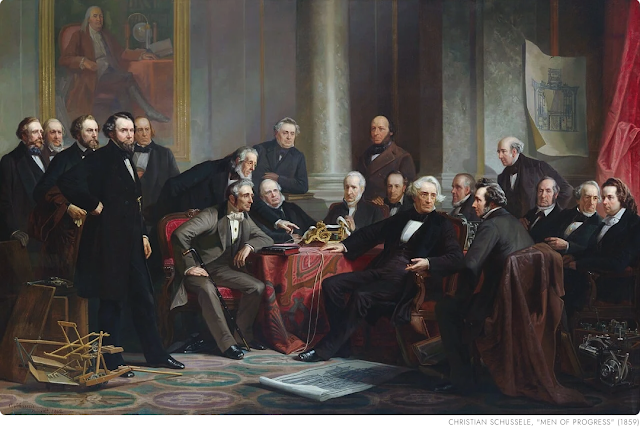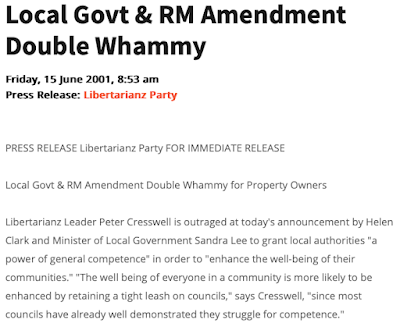The so-called “Gilded Age” of "Robber Barons" should be better named, says Andrew Bernstein in this guest post. It should be known as the Inventive Period of Capitalism.The Inventive Period
by Andrew BernsteinA recent issue of
American Heritage magazine, devoted to analysing important cultural issues in U.S. history, contains an article that provides ample clues to the true nature of late nineteenth-century America. The piece, “
People of Progress,” features the greatest innovators of the twentieth century, and takes as its point of departure Christian Schussele’s famed 1862 painting, “Men of Progress,” a depiction of 19 great American inventors and creative thinkers of the first half of the nineteenth century.
Schussele’s painting portrays such men as Cyrus McCormick (1809-1884), the inventor and manufacturer of the reaping machine and other agricultural equipment; Charles Goodyear (1800-1860), who created the vulcanization process that made rubber useful; Samuel Colt (1814-1862), the gun inventor and manufacturer; Peter Cooper (1791-1883), the builder of the first American steam locomotive; Samuel Morse (1791-1872), the innovative thinker responsible for both the electric telegraph and the Morse Code; William Morton (1819-1868), the dentist who co-discovered ether’s use as an anesthetic; and Elias Howe (1819-1867), inventor of the sewing machine. These, as well as 12 other equally accomplished thinkers and inventors, form the subject of Schussele’s masterpiece.
The administrators of the Cooper Union for the Advancement of Science and Art (founded by industrialist and inventor Peter Cooper in 1859
1) recently commissioned one of its leading graduates, the artist Edward Sorel, to paint a sequel to Schussele’s work—a portrait of 20 innovative Americans who changed the world in the twentieth century. Sorel, with assistance from the editors of
American Heritage and
American Heritage of Invention & Technology, chose the subjects. And not surprisingly, some of the geniuses depicted started their brilliant careers in the second half of the nineteenth century.
Anti-capitalist historians regularly refer to this late-nineteenth-century era as “the Gilded Age” and deride its great industrialists as “Robber Barons.” They claim that its extensive industrial development was achieved by means essentially tawdry and unprincipled. They are profoundly mistaken and have failed to identify the essence of the era. It must be known as the Inventive Period.
In Schussele’s painting, Benjamin Franklin looks down on those assembled as both inspiration and presiding genius. Sorel grants this honor to Thomas Edison. Edison (1847-1931) is the exemplar of his age. He is widely known as the inventor of the electrical lighting system, the phonograph, the electric generator, and the motion-picture projector. He also later coordinated movies with phonographic sound to create the world’s first multi-media presentation. But Edison is by no means alone in exemplifying the scientific/technological genius of the period. Sorel’s portrait projects numerous other great minds.
Among them are George Washington Carver (1864-1943), the brilliant black American botanist and agronomist, who developed a new type of cotton, Carver’s Hybrid. Born a slave, he is most famous for developing sweet potatoes and peanuts as leading crops, but he also invented hundreds of plant-based products, taught methods of soil improvement and, by means of his discoveries, induced southern farmers to grow crops other than cotton. Also included is Charles Steinmetz (1865-1923), the German immigrant who went to work for General Electric as its first director of research and development and in the 1890s pioneered the understanding of electrical transmission.
Neglected Geniuses
Since Schussele’s portrait concentrates on the early nineteenth century and Sorel’s on the twentieth, there are many great late-nineteenth-century thinkers who are included in neither painting. Here we can cite merely a few. One is George Eastman (1854-1932), who in 1884 patented the first film in roll form to prove practical. In 1888 he revolutionized photography by perfecting his Kodak camera, and in 1892 established the Eastman-Kodak Company, one of the first to mass-produce standardized photographic equipment. Another is Cyrus W. Field (1819-1892), an entrepreneur whose interest in transoceanic telegraphy led to the completion in 1866 of the transatlantic cable. Field later was instrumental in laying the cable that linked the United States to Australia and Asia by way of Hawaii.

The advances in architecture wrought by William Le Baron Jenney (1832-1907) and Louis Sullivan (1856-1924) must not be overlooked. Jenney, an engineer in the Union Army during the Civil War, settled in Chicago and opened an architectural office. He pioneered the use of iron-frame construction for large buildings, which he first employed in the
Home Insurance Company Building in 1885. His revolutionary method of curtain-wall construction is still used today and earned him the title of “father of the skyscraper.” Sullivan apprenticed with Jenney early in his career. Later, it was his designs for steel-frame buildings that resulted in the establishment of the skyscraper as a distinctively American type of building.
George Westinghouse (1846-1914) introduced numerous inventions in various fields, but concentrated on the railroad industry. Before the age of 20, he created the “railroad frog,” an invention that permitted trains to switch tracks. His most famous advance was the air brake, invented around 1866, which became a standard feature on all trains. Westinghouse developed hundreds of innovations, acquired more than 400 patents and, together with the Croatian immigrant Nikola Tesla (1856-1943), pioneered the use of alternating current (AC) power in the United States. Tesla invented the AC induction generator in the 1880s, the first practical motor powered by alternating current. He sold the patent to Westinghouse, who put it to commercial use in the Niagara Falls power project. Westinghouse and Tesla demonstrated that alternating current was able to generate electrical power over great distances more economically than the direct current favoured by Edison.
John Roebling (1806-1869), a German immigrant, pioneered the construction of suspension bridges in the United States in the second half of the nineteenth century. He demonstrated the practicality of using steel cables in bridge construction—and today, early in the 21st century, several of his bridges still stand, including the famed Brooklyn Bridge in New York, constructed in the 1870s. Another great creator, largely forgotten today, is the U.S. Army surgeon and bacteriologist Walter Reed (1851-1902). In the 1890s, Reed’s investigations contributed greatly to the understanding of typhoid fever, leading to the control and prevention of epidemics of the disease. In 1900 Reed demonstrated that the yellow-fever virus was transmitted by the bite of the mosquito
Aedes aegypti. By exterminating the mosquitoes, the disease was virtually wiped out.
A great thinker from the Inventive Period who is widely remembered is the Scottish immigrant, Alexander Graham Bell (1847-1922). In 1874, his work on the multiple telegraph gave him the idea for the telephone. Experiments with his research assistant, Thomas Watson, proved successful on March 10, 1876. Later that year, Bell demonstrated the telephone at the Centennial Exposition in Philadelphia, an event leading to the organization of the Bell Telephone Company in 1877. Bell’s other inventions include the audiometer, a device for measuring hearing acuity and, later in life, the aileron and other aeronautical advances.
Space does not permit even the mention of all the inventors, entrepreneurs, and groundbreaking industrialists who flourished during the period. The achievements of Frank Julian Sprague (1857-1934), for example, are no longer remembered. Sprague, a brilliant electrical engineer who graduated from Annapolis and worked for Edison, electrified Richmond’s trolley system in 1888. He demonstrated that electricity was cheap, and that it could be used on both surface and elevated cars. In 1890 about 15 percent of America’s urban transit mileage was electrified; by 1902, 97 percent.
On the eve of the twentieth century America’s technological advances were only beginning. On the morning of June 4, 1896, Henry Ford (1863-1947) battered down the brick wall of his rented garage with an ax and drove out his first car. Others, of course, had already built and run cars, but Ford began the Ford Motor Company in 1903 and made the automobile a commercial reality. Soon millions of Americans were driving cars. That same year, Wilbur (1867-1912) and Orville (1871-1948) Wright, two bicycle mechanics from Dayton, Ohio, who were self-educated regarding the principles of aeronautical engineering, accomplished the first controlled, powered flight of a heavier-than-air vehicle at Kitty Hawk, North Carolina. Throughout the 1890s, the Wrights had been studying aeronautics and experimenting with flying devices. Both the automotive and aviation ages dawned in early twentieth-century America as a direct outgrowth of the achievements of the late nineteenth. (Ford and the Wright brothers are included in Sorel’s painting.)
The Underlying Factor
What underlying factor was responsible for this unprecedented outpouring of innovations, inventions, advances, and new products? The answer should be obvious, but unfortunately, to many historians it is not.
It was the political and economic freedom of the capitalist system that enabled these inventor-entrepreneurs to flourish.The late nineteenth century (until the proliferation of trust-busting and government controls in the early twentieth century) was the freest period of American history. The leading economists, professors, legal theorists, and judges upheld the principles of individual rights, limited government, economic freedom, and profit-making. Economists such as Amasa Walker, Arthur Latham Perry, and Francis Bowen wrote the leading economics textbooks of the day. Their works—
Science of Wealth,
Elements of Political Economy, and
American Political Economy, respectively—championed the ability of the free market to create wealth and upward economic mobility.
2 William Graham Sumner (1840-1910), the leading American social scientist of the late nineteenth century, wrote of “The Forgotten Man,” the honest labourer who supported himself by productive work. The principle of the Forgotten Man is that he needs the liberty of the American system if he is to flourish. He is the one always victimised by the socialists’ schemes to redistribute the income earned by private individuals.
3The law writers and legal philosophers of the day shared the same commitment to limited government. The most prominent, Thomas Cooley and Christopher Tiedeman, wrote their major works in the second half of the nineteenth century. The upshot of both Cooley’s
A Treatise on the Constitutional Limitations Which Rest Upon the Legislative Powers of the American Union (1868) and Tiedeman’s
A Treatise on the Limitations of the Police Powers of the States(1886) was the defense of property rights.
4In practice, most American judges of the period agreed with the individualistic principles of the country’s leading legal philosophers. After the Civil War, American courts generally presumed to be unconstitutional any laws restricting property rights and the rights of both businessmen and workers to set the terms of labor that they deemed best. As one example, the New York State Court of Appeals in 1885 struck down legislation seeking to limit the hours of industrial employment, ruling that such a law violated the rights of both worker and employer to engage in a voluntary transaction.
Additionally, the American courts of the late nineteenth century repeatedly placed severe limitations on the government’s power to tax and to subsidize business ventures. The courts generally gave strong support to the capitalist principle that productive enterprise was to be privately funded, owned, and operated. One representative ruling by a Missouri court in 1898 found against governmental paternalism, whether state or federal, and proclaimed that individuals know best how to conduct their own business and personal affairs.
5In this era, the U.S. Supreme Court gradually came to be the great defender of an individual’s right to property, freedom of contract, and economic liberty. For example, Stephen J. Field (brother of Cyrus Field), for many years a distinguished Justice of the high court, issued pro-freedom dissenting opinions in such famous disputes as the Slaughter-House cases (1873) and Munn v. Illinois (1877), holding that the government could prevent neither employers nor workers from entering fields of their own choosing or violate the right of individuals to the full use and disposal of their property. The majority opinion at this time was that the Fourteenth Amendment protected the rights of the recently freed slaves only and that there was nothing in it to prevent the states from interfering in business activities. But by the mid-1880s, after the San Mateo case (1882) and the Santa Clara case (1886), Justice Field prevailed. Chief Justice Morrison Remick Waite, in an oral statement, spoke for a unanimous bench in 1886, proclaiming that all the justices “understood and accepted the fact that corporations were persons within the equal protection clause of the Fourteenth Amendment.” The right of individuals to work and to use their own labor and property as they saw fit now came under the legal protection of the Supreme Court.
6Religion and Capitalism
Religious leaders of the period characteristically upheld the virtues of work, frugality, sobriety, and wealth earned through honest effort. The weekly religious periodical
The Independent, edited for a while by the noted Congregationalist minister Henry Ward Beecher (1813-1887), defended the free market as the means by which both capitalists and workers would achieve material gain. For almost four decades Beecher preached from his influential Brooklyn pulpit the ability of hard-working individuals to rise economically in the capitalist system.
7The intellectual, cultural and political climate of the country upheld freedom, limited government, and property rights in this era. The economic results are not surprising. The most innovative and creative minds were free to develop new products and methods, to start their own companies, to bring their innovations to the marketplace, to convince consumers that the new products were superior to the old and, in time, to earn fortunes. There were few government bureaucrats and regulators to prohibit their activities, restrict their output, dictate working conditions, or limit their market share. “The first condition of this proliferation was that the innovations did not require the assent of governmental . . . authorities.”
8Most of the innovators of the Inventive Period were entrepreneurs who sought and made wealth by virtue of their creative work. Edison retired with a net worth of $12 million, an enormous sum in those days. His inventions were profit-driven. “Edison’s Menlo Park laboratory was conceived to bring scientific knowledge to bear on industrial innovation . . . . Its inventions were goals chosen with a careful eye to their marketability.”
9Such instances were numerous during the Inventive Period. Eastman, Westinghouse (Westinghouse Electric Company), and Ford are all examples of innovator-entrepreneurs who developed their new products into profitable business ventures. Willis Carrier (1876-1950) invented the air conditioner in 1902, held more than 80 patents by the 1940s, and founded the manufacturing firm that bears his name. (He also made Sorel’s painting.) Bell’s most famous invention led, of course, to the founding of the Bell Telephone Company. Roebling made a fortune from his wire-manufacturing company, as did McCormick from his firm’s producing the reaping machine and other farm equipment. Colt was an entrepreneur who opened his own plant, Colt Patent Arms, in 1855. He pioneered advanced manufacturing methods such as the production line and the use of interchangeable parts, making his company the largest private armory in the world. Isaac Merritt Singer (1811-1875) wanted a commercially practical sewing machine and brought together several related patents to create his immensely popular product. By 1860, he was the largest manufacturer of sewing machines in the world. A business innovator, Singer began such practices as installment buying, advertising campaigns, and service with sales.
Because of the climate of political and economic freedom during the Inventive Period, America’s entrepreneurs were able to revolutionise the fields of heavy industry on which general prosperity depended. Between 1860 and 1900, American output of bituminous coal increased by 2,260 percent, crude petroleum by 9,060 percent, steel by 10,190 percent, and other industries increased by similar amounts.
10 Industrialists such as Andrew Carnegie (1835-1919) and John D. Rockefeller (1839-1937) built Carnegie Steel and Standard Oil into enormously productive concerns that flooded the country with steel and oil products. In the 1880s and 1890s, the great railroad man James J. Hill (1838-1916) constructed the Great Northern Railroad with only private funds to the immense betterment of people in the northern plains and northwest states. It goes without saying that Carnegie, Rockefeller, and Hill earned great wealth.
The lesson of the Inventive Period can be applied today. Political and economic freedom will lead to widespread innovation. This principle can already be seen in the computer industry, in which the relative absence of government regulation has enabled such innovators as Steve Jobs, Stephen Wozniak, Bill Gates, Paul Allen, Michael Dell, Larry Page, Sergey Brin and others to create an information revolution, and to earn fortunes in the process.
To defend freedom against the distortions of the anti-capitalist historians it is important to reject the inaccurate and opprobrious title of “the Gilded Age” for the late nineteenth century. We must recognise and celebrate the true nature of the era.
It was the Inventive Period.
NotesSee www.cooper.edu/engineering/chemechem/general/cooper.html.
Louis M. Hacker, The World of Andrew Carnegie, 1865-1901 (New York: J.B. Lippincott, 1968), pp. 68-73.
Ibid., pp. 81-85.
Ibid., pp. 86-92.
Ibid., pp. 95-96.
Ibid., pp. 98-107.
Ibid., pp. 74-80.
Nathan Rosenberg and L.E. Birdzell, How the West Grew Rich (New York: Basic Books, 1986), p. 265.
Ibid., p. 250.
Hacker, p. xxxi

























